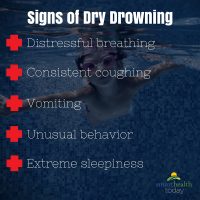
Dry drowning has nothing to do with sand or heat—and everything to do with water. Learn what it is and its warning signs.
Most parents take five from lifeguard duty when their little ones hop out of the pool or make their way from the surf. Once they’re toweled off, it’s time for juice boxes, snacks and maybe playing in the sand. Right? Hopefully in most cases. But, dry drowning, also known as secondary drowning, can occur hours after your kiddo’s swim session has ended.
We asked Dr. Danelle Fisher, vice chair of pediatrics at Providence Saint John’s Health Center in Santa Monica, Calif., to share crucial information to ensure a safe summer while having fun in the sun—and the water.
Defining Dry Drowning
First, it’s important to understand what dry drowning is because the name can be a bit confusing. It has nothing to do with sand or heat—and everything to do with water.
“Drowning from fluid in the lungs that occurs not during submersion in water, but up to 24 hours after swimming or bathing, defines secondary drowning,” says Dr. Fisher. “If the child inhales water into the lungs, the vocal cords can spasm. The drowning is defined ‘dry’ because it occurs out of the water.”
Warning Signs
Because you might not witness your child inhale and swallow pool, ocean or even bath water, it’s important to know the signs. Dr. Fisher says to watch for distressful breathing, consistent coughing, vomiting, unusual behavior or extreme sleepiness.
Seek Professional Help
If you witness an event in the water, the lifeguard can and will perform initial lifesaving measures, but further observation should be in a medical facility.
“Go to the ER,” advises Dr. Fisher. “Treatment of dry drowning includes obtaining a chest X-ray, having an IV and being monitored for signs of respiratory distress or compromise.”
Don’t Be Fooled
Most importantly, Dr. Fisher wants parents to know that dry drowning is very sneaky.
“Drowning conjures images of someone thrashing around in a body of water, not a child who went swimming several hours ago,” Dr. Fishers says.
She’s right. Think of your child at home resting on the couch, worn out by sun and swimming. Your child is only tired, right? Not dry drowning. Or is she?
“The scary part is the timing of the drowning, up to 24 hours after an event in the water,” Dr. Fisher says.
Even more scary: Dry drowning can occur while the child is napping or down for the night. Why? Water in the lungs can induce vomiting, followed by choking.
Prevention Is Key
Dry drowning can be prevented by taking appropriate precautions around water, according to Dr. Fisher.
“Children over the age of 4 years should have swim lessons and be supervised by at least one adult at all times while near a body of water, including bathtubs,” Dr. Fisher says.
In addition, parents and caregivers should know CPR. Proper fencing around swimming pools is an important safeguard, too. Don’t forget about boat safety: Passengers of all ages on a boat need to wear a life jacket.
“My No. 1 piece of advice when it comes to summer safety involving large bodies of water is to have someone with your child at all times. Incidents leading to dry drowning can occur in a matter of seconds,” Dr. Fisher says.
Information provided by www.parenting.com



